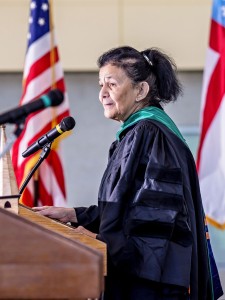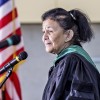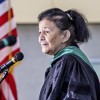The following is the prepared text of the inauguration keynote address, “The Secret to Julie Kornfeld,” delivered by Dr. Wafaa El-Sadr, global health expert and MacArthur Fellowship recipient, at the installation ceremony of Julie Kornfeld on April 13, 2024.
Thank you to the entire Kenyon community for inviting me to participate in this wonderful inauguration event. Under any circumstances, it would be a delight to visit this lovely campus with its verdant setting and illustrious history as a haven for the ideas — and ideals — that have given shape to American scholarship for 200 years.
Today, the pleasure is multiplied, as I have the distinct privilege of celebrating a longtime colleague and friend — Julie Kornfeld — as she officially becomes the 20th president of Kenyon, a role that promises to catapult her to new levels of achievement in her already illustrious career, while at the same time promising the kind of strong, compassionate, visionary leadership that will lead Kenyon boldly into its future.
Now I have a confession to make. When I was asked to provide an introduction for Julie on this most auspicious occasion, I was immediately thrilled and honored. But, about 30 seconds later, these feelings were overtaken by, how shall I put it? Well, terror.
To be clear, this wasn’t stage fright. I speak publicly often at academic, medical and public health meetings and conferences. But this particular speaking engagement was truly intimidating. And the reason is simple. My task was to capture and express the qualities of a truly exceptional individual in just a few minutes. “How do I do justice to Julie?” I kept asking myself, again and again.
Could I adequately sum up Julie’s remarkable career to date? Could I articulate the essence of what makes her so successful? Could I possibly transmit to you the depth of my admiration for her or the marvelous qualities that make her both a superstar in her field and the loveliest of human beings? This was not going to be a walk in the park.
So, as I scientist, I did what comes naturally. I started researching my subject.
I began by charting my professional relationship with Julie over the years.
I reflected back to the first time I met her. I was co-chairing a search committee seeking a candidate for the position of vice dean for education at the Columbia University Mailman School of Public Health. We were struggling to find someone we thought could take on these critical responsibilities and take this office to the next level. Then someone suggested Julie — and it was like a lightbulb switching on.
We promptly scheduled her for an interview. I distinctly remember the moment Julie walked into the room. She was like a ray of sunshine breaking through thick clouds. It did not take more than a few minutes for me to realize that we had found our top choice. And the committee unanimously agreed.
I know I speak for that entire committee when I say that it was one of the best decisions any of us had ever made.
Furthering my investigation, I recalled, as well, my experience traveling with Julie. As the head of the global health center, ICAP at Columbia University, I had the occasion to travel with Julie to visit our programs in sub-Saharan Africa.
Now, I often say that one way to really get to know people is when you travel with them. Travelling with someone can make or break relationships, as many of you likely will agree. Travelling unveils the best and the worst of people. It can build lasting friendships or abruptly put an end to them.
It was bringing Julie to visit some of the most challenging environments on the planet that my admiration for her — already sky high — reached the stratosphere. Her openness to learning, her ability to size up organizations and ask pithy, probing questions, her sixth sense about people — she showed me all this and more during our journey.
I vividly remember visiting with Julie a gender-based violence center that ICAP helped establish in western Kenya. As you can imagine, this was quite an intense visit. The center staff talked to us about their distress at having to listen to and deal every day with horrific stories of violence and abuse. We listened to survivors of gender-based violence and their own tales of fear and despair, and how the center staff had supported them throughout their ordeal and beyond.
In reality, one never knows how people will respond in such a setting. While some may have sat there and just listened and nodded, it was evident that Julie genuinely cared. She never hurried the speakers or gave perfunctory nods. Through every gesture, every question and every response, she showed authentic understanding and empathy. I knew then that this was a friendship that I would treasure for life.
This was a start, but I needed more. I needed to supplement my empirical observations with other evidence. It was time to get some data!
I asked several of my colleagues who have worked with or knew Julie if they would share with me a few words that come to their mind when they think of her. I immediately got a deluge of responses. Here is some of what they told me:
Through a professional lens, they characterized Julie as: Smart. Strategic. Creative. Decisive. Resilient. Brilliant. A collaborative leader. Unafraid to confront and navigate challenges.
Those who had experienced her as a leader said that Julie leads with compassion, empathy, strength, humor, and personal engagement.
When it came to her personal qualities, they were just as effusive, describing her as: Gracious and graceful. Inspired and inspiring. Kind. Inclusive. Warm. Upbeat. Engaging. Elegant. Fun. Devoted to her family and friends.
Needless to say, these comments fully confirmed my opinion of Julie. The fact that so many others were able to render such praise was more evidence of what an extraordinary person she is.
But, still, something was missing. I still hadn’t managed to sum up what it is about Julie that makes her such an exceptional fit to lead this great institution.
Then, doing more research, I came across an interview she did for you here at Kenyon after her selection to lead this institution. “Twenty questions with Julie Kornfeld,” it was entitled. In one of those questions late in the interview, Julie was asked about her hidden talent. When I saw Julie’s response, I knew that her answer was the clue that I was missing.
Dancing.
That was it! Julie is a dancer.
Now just so we’re clear, I have never seen your new president on the dance floor or the ballet stage or anywhere else. But I don’t need to. Because Julie approaches everything like a beautiful dance.
You can see it when she deals with an individual. The rapport she cultivates, the give and take, the empathy and the subtle cues to help foster mutual understanding.
You can see it when she’s working with a group. She orchestrates cooperation, choreographs collaboration, turns discord into harmony.
At Columbia — I saw this again and again — Julie got people who had never worked together — or maybe to put it more accurately never wanted to work together — to join forces and work towards the common good. I saw her waltzing through the seemingly endless line of challenges, one by one turning them, bringing them into step with her, transforming obstacles into opportunities.


